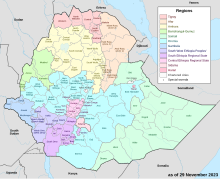
Amaro Zone (Kore) is a zone in the south-west Ethiopian Regional State of Ethiopia, and the people are called Kore, and their language is Korigna. The Amaro Kore people are the descendants of the Christian missioners of the north Ethiopian sematic peoples of Gonder, who were moved gradually through the northern shewa (menze) to the central and south-western Ethiopian lands of Damot (wolayta), Dawuro, Gamo Gofa, and surrounding areas of the region with their Christian traditions and heritages around the eleventh, twelfth, and thirteenth centuries. As the native of kore nation Theologian Jebdu kassahun evidentially assured and narrated, that was a time of ST. Abune Gebremenfes kidus, st.tekle Haymanot, and emperor Yikuno Amlak, who were preached and expanded Christianity to central and south western Ethiopian lands. Amaro is one of the areas in which members of Kore nations widely live in. Amaro Kore people got zonal status in August 2023 A.D upon the formation of the South west Ethiopia Regional State. In 2011 A.D, the Segen Area Peoples Zone was established, which includes Amaro woreda and the three former special woredas surrounding it.[1] Located in the Great Rift Valley, Amaro kore peoples land is bordered on the south by Burji Zone, on the southwest by Konso Zone, on the west by Dirashe Zone, on the northwest by Gamo Zone and Lake Chamo, and on the north by Lake Abaya and in east and northeast by Oromia Region. It is divided into 35 kebeles. The administrative center of the woreda is Kelle, and Jijola woreda, Derba Menena woreda, and Kereda are other growing municipals of the zone. The highest peak in the zone is Mount Dello (3600 meters), which is part of the Kore mountains, the highest in Jemjem plateau and the second from the region. Much of the western part of this zone lies inside the (Enee Shanka) Nechisar National Park. The major crops grown in Amaro are enset (Enset ventricosum), teff, maize, wheat, barley, navy beans, and coffee.[2] Amaro has 39 kilometers of all-weather roads and 16 kilometers of dry-weather roads, for an average road density of 36 kilometers per 1000 square kilometers.[3] The Central Statistical Agency (CSA) reported that 1,082 tons of coffee were produced in the year ending in 2005, based on inspection records from the Ethiopian Coffee and Tea authority. This represented 0.48% of the Southern Nations, Nationalities and Peoples' Region (SNNPR)'s output and 1.08% of Ethiopia's total output.[4]
This zone was selected as one of the three areas for Agri-Service Ethiopia to implement an Integrated Food Security Program. This Program operates in 10 of the woreda's kebeles, with the goal of improving agricultural practices, developing new rural water sources, and maintain and improve the existing local schools.[2]
Kore is well known and rich by yearly overflowing rivers. Bewaye, Sarmale (Segen), Duano, Kondilcho are some of them. with the time now, due to the number of the people are increasing in alarming rate and the societies facing many challenges that arise from mal-administration from so-called segen zone, peoples are demanding the demolition of the zone and strongly claiming the assurance of their own right to self-administration under the status of independent Amaro Kore zone.
- ^ Misganaw Addis Moges (June 2014). "Practice of Self-government in the Southern Nations Nationalities and Peoples' Regional State: the Case of Segen Area Peoples' Zone" (PDF). Addis Ababa: Addis Ababa University College of Law and Governance – Studies Centre for Federal Studies. p. 5.
- ^ a b "Operational Areas" (Agri-Service Ethiopia)
- ^ "Detailed statistics on roads" Archived 2011-07-20 at the Wayback Machine, SNNPR Bureau of Finance and Economic Development website (accessed 15 September 2009)
- ^ CSA 2005 National Statistics Archived November 23, 2006, at the Wayback Machine, Table D.2